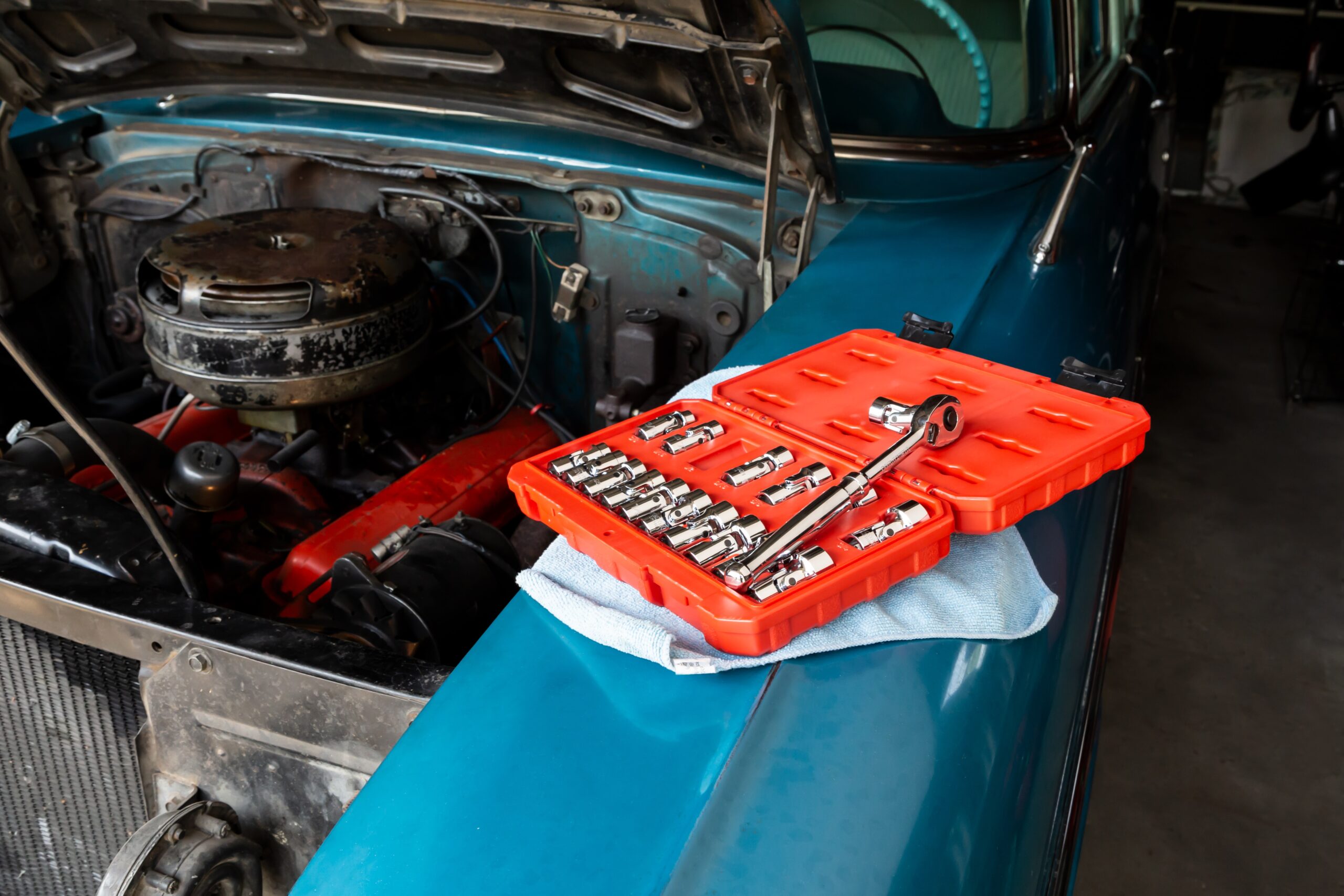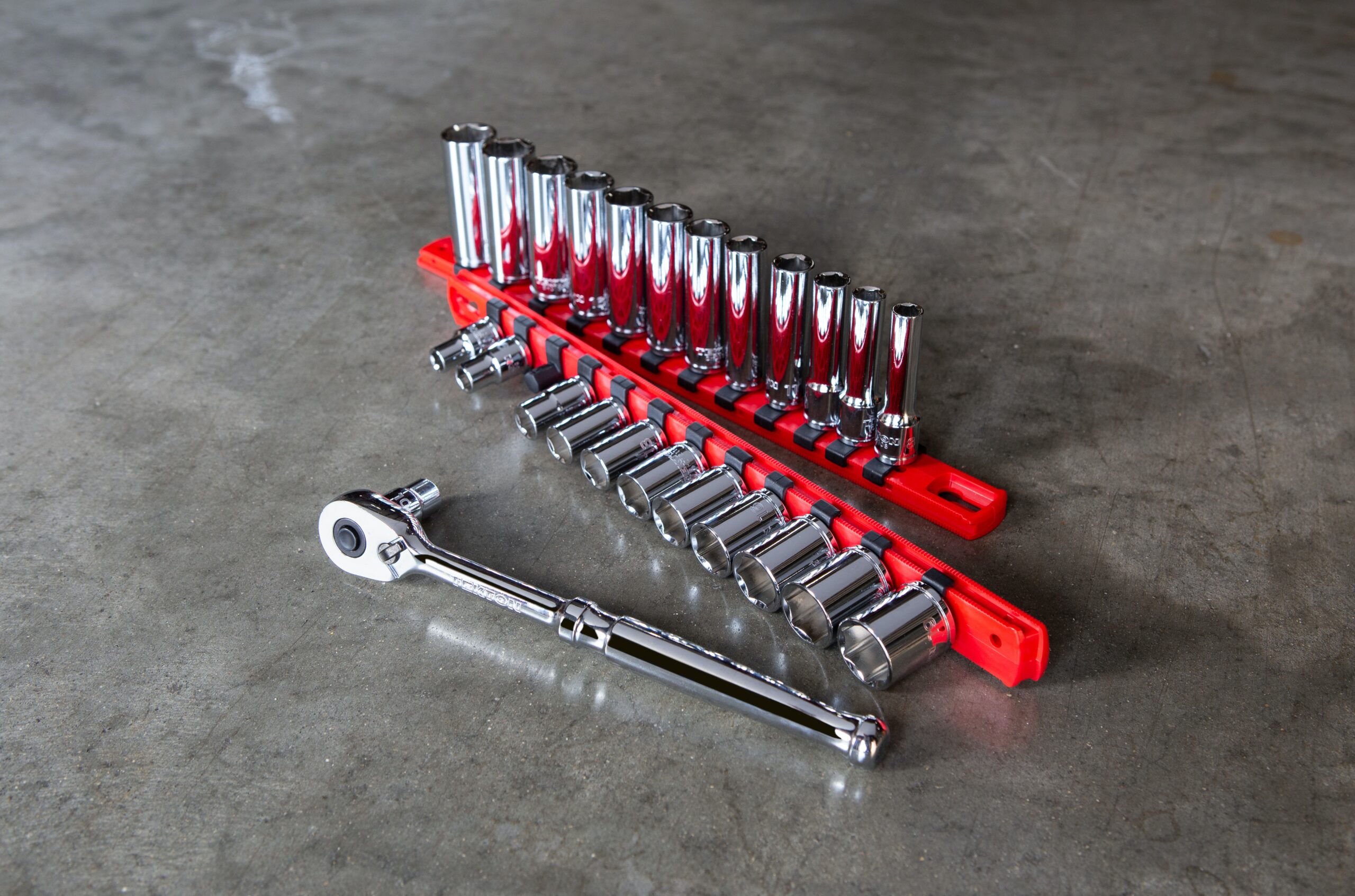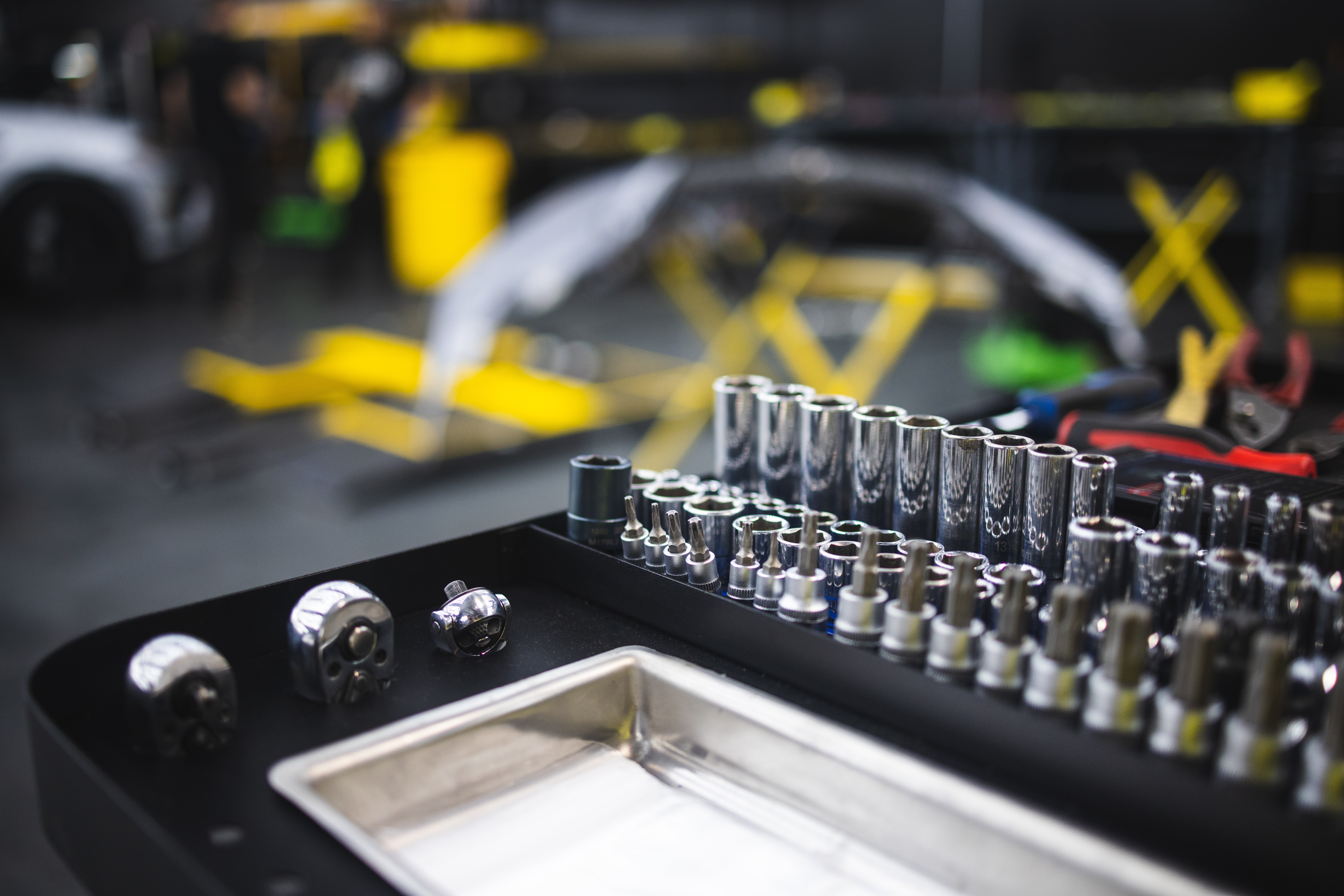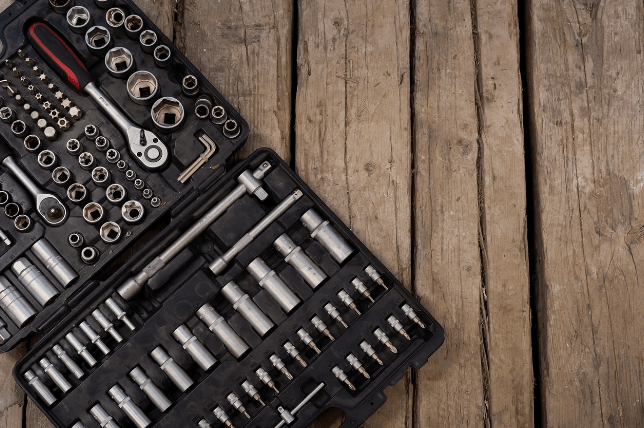You’ve probably seen a wrench, ratchet, and socket in action at some point. However, for the novice, these tools may be intimidating because they aren’t used as frequently or their use isn’t as intuitive as a hammer or screwdriver. Sockets and ratchets serve the same purpose as wrenches.
These simple mechanical tools, on the other hand, enable the user to perform the work of loosening and tightening screws in a more effective manner.
History
Prior to the invention of sockets, spanners were the primary tools for rotating fasteners such as nuts and bolts. Because sockets could be changed, a set of sockets with a turning tool took up less space than a set of spanners, causing sockets to become more popular. The actual date when the socket was invented is unknown.
For centuries, sockets have been used. Female drivers were commonly used in early sockets. The female is the part that the male fits into when it comes to sockets, screwdriver bits, and fasteners. When tightening a nut or bolt with a hex socket, the male part is the bolt head or nut, which fits into the female socket head and allows the nut/bolt to be twisted, tightening or loosening it.
A torx screwdriver bit of a socket bit, for example, is the male part that is inserted into the female head of a fastener to turn/drive it into the workpiece.) square fastener heads only, as these were easier to manufacture than hex ones due to filing manufacturing methods at the time.
Sockets were meant to slot into or onto non-ratcheting wrenches, such as turning wrenches. The middle-age keys used to wind clocks were common early kinds of sockets.
J.J. Allen designed the first ratcheting wrench for use with interchangeable sockets. Richardson was born in 1863. The earliest depiction of this ratchet came in a Scientific American edition in 1864, and it depicts two distinct sizes of interchangeable square sockets.
Following the Industrial Revolution at the end of the nineteenth century, the rise of milling, shaping, broaching, forging, and other modern manufacturing techniques made other shapes such as hex heads just as easy to make as square ones.
Hex head sockets grew in popularity over square ones because they allowed fasteners to be tightened or loosened with smaller wrench motions. This was especially useful in tighter spaces where items could obstruct the swinging movement of a wrench.
Ratchets help to alleviate this issue as well. The combination of sockets and ratchets is now so prevalent that many people refer to a non-ratcheting socket wrench as a nut driver rather than a socket wrench.
Powered wrenches for use with sockets became introduced in the twentieth century. These are typically electric or compressed air-powered, though hydraulic ratchets are also used in heavy industry when very high torque is required. Some powered wrenches can also function as impact wrenches when used with impact sockets.
How Ratchets and Sockets Work
A ratchet is a handle that is connected to one end of a socket by a square-drive connector. The socket’s other end fits over a fastener. A mechanism in the ratchet allows the handle to engage and tighten the fastener when swung clockwise and freely when swung counterclockwise. To loosen the fastener, a switch on the ratchet reverses the process.
Ratchets and sockets are two examples of wrenches intended for specialized applications. They tighten and loosen fasteners in the same way that a traditional wrench does. However, there are some tasks that are particularly well suited to a ratchet and socket. A ratchet and socket combination (also known as a socket wrench) allows you to turn a nut or bolt without having to reposition the tool on the fastener, as you would with a wrench when there isn’t enough room to turn it in a full circle. This can speed up the process.
Furthermore, because a socket completely surrounds a fastener, it is less likely to slip off than other types of wrenches.
What Are Socket Wrenches and Ratchet Sets Used For?
Despite their versatility and utility, socket wrenches and ratchets have simple functions.
The tool’s handle is grooved to improve grip, and one end has a square male connector that fits into a similarly sized inlet on the underside of each ratchet head. The opposing side of the head has a hexagon shape that is designed to fit over various nut and bolt sizes.
A cog mechanism inside the handle’s top permits the head to move in just one direction at a time. If you try to move the head in the opposite way, a spring-loaded pawl catches the back of the cog’s tooth and stops it from moving. This force can then be used to release or tighten nuts and bolts.
Socket wrenches and ratchets are essential equipment for any complex or specialist activity, such as mechanics, as well as more common DIY-type projects, such as home maintenance.
Types of Socket Wrenches and Ratchet Sets
Here are some of the most common types of socket wrench and ratchet sets you’ll come across while shopping:
1. Metric socket set
Because metric socket sizes are measured in millimeters, they are perfect for working on foreign automobiles. The most frequent metric sizes are 10mm and 36mm.
2. Deep socket set
These sockets are at least one inch long and allow you to reach nuts that would otherwise be inaccessible. They’re ideal for working in engine bays and other difficult areas.
3. Impact socket set
Rather than a standard ratcheting mechanism, impact sockets include a small hammer built into their heads that strikes an anvil with each ‘click,’ providing more force. Impact sockets are ideal for situations requiring more force, such as seized nuts and bolts.
4. 3/8 socket set
SAE (Society of Automotive Engineers) sockets are measured in inches and fractions of an inch rather than metric. 3/8″ is one of the most commonly used sizes for automobile bolts.
5. 1/2 socket set
Slightly larger sockets with enough force for practically any application.
6. 1/4 socket set
Ideal for precision work with smaller sockets.
Socket vs. Ratchet
Although they are two distinct parts, the terms ratchet and socket are frequently used interchangeably. The ratchet is the handle mechanism that includes a cog. In comparison, the socket, or head, is what connects to nuts and bolts. Socket wrenches are a grouping of these tools.
Features to Look for in a Socket Wrench and Ratchet Set
You want to spend your money on tools that will last a long time. Ratchet sets composed of Cr-mo steel and vanadium coated often survive more use and abuse, including rust, than other materials.
Stamped Sizes
Cr-mo steel resists wear and tear, allowing your stamped sizes to remain clear for longer. Sizes that have been laser-etched or roll-stamped often endure longer.
Tooth Count
The more teeth your wrench has, the more precisely each ‘click’ will be. This increases torque while reducing much of the play between cog teeth.
Size
The more sizes you have in your ratchet set, the more projects you can do on your own. This is when having a socket wrench set with both SAE and metric sizes could come in handy.
Grip
When delivering torque, you want the best grip possible to prevent your hand from slipping. Some types have laser-etched grooves, while others are curved to provide maximum hand comfort.
Attachments
When it comes to socket wrench attachments, the sky is the limit, and only your demands limit you. Socket extensions, sockets with universal joints, and impact driver adapters are all common attachments.
Uses
A socket set is a versatile and convenient bundle of toolkit accessories that allows users to tackle a wide range of fastener sizes and kinds, primarily geared at fitting to a variety of nuts and bolts. Socket sets are typically packaged in a single portable case, box, or pouch containing a variety of replaceable attachments.
In fact, because there are so many different shapes and sizes of nuts, bolts, and other fasteners available, no one socket set kit (also known as ratchet and socket sets or socket wrench sets, depending on what’s included) is likely to include add-ons for every single kind of fastener.
The majority of complete sets have sockets for the majority of fastener types, but not all available sizes. Knowing which kind of nuts and bolts you’re likely to meet in your day-to-day work, like with most toolkit items of this type, is thus a key consideration in determining which socket set – or combination of sets – is best for you.
What is the purpose of socket sets?
Ratchet and socket sets are typically used to tighten or loosen a wide range of fastener sizes and types. Because many standard socket sets include attachment sizings to suit the most common nut and bolt gauges on cars, trucks, buses, and other vehicles, they’re especially popular among professional or DIY/enthusiast mechanics in both commercial and home garages.
Socket sets, in addition to being practical and versatile, can make certain difficult activities easier by adding an extra level of user-friendliness.
How to Make Use of a Socket Set
Socket sets are normally quite easy to use, and almost always include a no-fuss quick-change feature that makes shifting between different sized attachments on the same wrench or ratchet spanner a breeze.
A socket set is a collection of various size attachments that slot or snap into the handle of a socket wrench, often known as a ratchet spanner or similar turning tool. This allows them to handle a wide range of nut and bolt shapes and gauges, and it provides significantly more ease and mobility than hauling about multiple individual spanners, ratchets, or torque wrenches in varied sizes from job to job.
When cranked clockwise, the ratcheting mechanism in a socket wrench allows for continual adjustment of the nut or bolt, but when turned anticlockwise, the tool rotates freely. This eliminates the need for the user to elevate and reseat the wrench when reaching the end of the comfortable turning arc or when operating in limited locations. This directional bias is frequently reversed by a simple switch on the ratchet handle, allowing for the same ease of use when loosening as when tightening fasteners.
Various types of socket sets
The main distinction between socket sets is often the range of fastener sizes they’re designed to fit over, and we’ll go over some common sizes and kit configurations in the following sections.
It’s also necessary to understand the many sorts of plugs available as a set. The following are some of the more popular socket wrench kits:
Impact socket sets
Impact driver socket sets work similarly to any other socket set, with the exception that they are meant for use with power tools such as electric or pneumatic air wrenches. Impact sockets are typically forged from slightly softer but thicker (and thus less shatter-prone) alloys such as chrome molybdenum steel, and are frequently dipped or coated to provide better anti-corrosion qualities.
Imperial socket sets
Socket sets with imperial measures are intended for use with fasteners with heads measured in inches and fractions of an inch. While this was once the accepted standard (and is still widely referred to as the SAE standard, an acronym for the Society of Automotive Engineers based in the United States), the majority of other countries around the world now prefer the metric system.
Deep Socket Sets
They’re also more frequently accessible in smaller sets or as individual attachments than conventional sockets – outside of automotive situations, toolkits with a complete complement of standard-length sockets, plus a narrower selection of deep sockets for more sporadic needs, are very typical.
Hex Socket Set
A hex socket set, also known as a 6-point socket set, is designed to fit over a conventional hexagonal nut or bolt head with six sides. These are the most common sockets.
They’re often favored for everyday use since they’re incredibly adaptable, fitting the majority of fasteners in most situations, and the fact that the socket makes six points of contact with the nut or bolt means it provides very reliable tightening and loosening purchase.
12-Point Socket Set
12-point socket sets, often known as ‘bi-hex’, work on the same idea as 6-point hex socket sets, except the recessed holes of the sockets have twice as many inner faces.
They provide 12 points of potential contact with the fastener, which can provide some significant advantages: in addition to making it faster and easier to seat the socket over most fastener types, a 12-point socket set allows for the use of square-head nuts and bolts (which cannot be fitted into a 6-point hexagonal recess at any angle).
The disadvantage of a 12-point or bi-hex socket is that the force is sent more directly to the corners of the fastener head, increasing the danger of rounding or stripping if too much torque is applied.
Conclusion
With such a diverse range of product kinds and sizes available, selecting the perfect socket set for the unique needs of a given work can appear to be a daunting endeavor. The beauty of many such kits, however, is that they are carefully developed and delivered in order to offer maximum flexibility and cost-effectiveness.
If you know what types of fasteners, you’re likely to face on a daily basis, there’s bound to be a socket set available that matches your demands.



